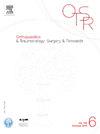青少年特发性脊柱侧弯手术后的妊娠和分娩:对80例妊娠的研究。
IF 2.3
3区 医学
Q2 ORTHOPEDICS
引用次数: 0
摘要
背景:青少年特发性脊柱侧弯(AIS)是一种常见的脊柱疾病,影响2%的青少年,90%的病例为女性。当选择手术治疗时,家庭和患者经常会询问许多关于脊柱融合术后怀孕和分娩过程的问题。这一主题在文献中很少被研究,尤其是在现代仪器技术方面。假设:目的是描述AIS手术后的妊娠和分娩,包括硬膜外镇痛的途径、剖宫产(剖腹产)的需要以及妊娠期间和之后的腰痛。因此,我们假设接受AIS脊柱手术的女性随后怀孕和分娩都没有并发症,并且可以像没有AIS的女性一样获得硬膜外镇痛。患者和方法:在这项回顾性多中心研究中,对1984年至2014年间从两所大学医院接受手术的198名女性进行了回顾。其中,有50名妇女怀孕,总共有80名妇女怀孕。收集手术数据(入路、最上面和最下面的器械椎骨(UIV、LIV))。评估妊娠特征:手术与妊娠之间的时间、分娩次数、镇痛方式、分娩类型、体重增加。使用ODI记录怀孕期间和随访时腰痛的发生情况。结果:50名女性中,34名接受了后部手术,16名接受了前部手术。交付时间为1988年至2018年。在80例妊娠中,81%通过阴道途径分娩(N=65/80),其中49%采用了有效的硬膜外麻醉(N=39/80)。硬膜外镇痛在9%的妊娠中失败(N=7/80),在35%的妊娠中被拒绝(N=28/80),一半的时间被麻醉师拒绝(N=15/80)。13例妊娠患者拒绝硬膜外麻醉(16%,N=13/80)。全身麻醉用于6例妊娠(8%,N=6/80),仅用于剖腹产。据报道,48%的孕妇出现背痛(N=38/80)。融合程度与剖腹产相关,与硬膜外麻醉相反。讨论:阴道分娩的正常妊娠似乎是接受AIS脊柱融合术的女性的规则。AIS妇女的剖腹产率与普通人群相似(19%)。然而,硬膜外麻醉似乎仍然存在问题,在这一系列中,只有49%的新生儿出生,而法国人口的这一比例为81%。证据水平:IV,回顾性队列。本文章由计算机程序翻译,如有差异,请以英文原文为准。
Pregnancy and childbirth after adolescent idiopathic scoliosis surgery: A study of 80 pregnancies
Background
Adolescent idiopathic scoliosis (AIS) is a common spinal disease affecting 2% of adolescents, and women in 90% of the cases. When a surgical treatment is opted for, many questions are frequently asked by families and patients about the course of pregnancy and childbirth after the spinal fusion. This subject remains little studied in the literature, especially with modern instrumentation techniques.
Hypothesis
The goal was to describe pregnancy and childbirth after AIS surgery in terms of access to epidural analgesia, need for cesarean section (c-section), and low back pain during and after pregnancy. We thus hypothesized that women undergoing spinal surgery for AIS have subsequently uncomplicated pregnancies and childbirths, and have access to epidural analgesia as women without AIS do.
Patients and methods
In this retrospective multicenter study, 198 women who underwent surgery between 1984 and 2014 were reviewed from two university hospitals. Among them, 50 women became pregnant, for a total of 80 pregnancies. Surgical data were collected [approach, uppermost and lowermost instrumented vertebra (UIV, LIV)]. Pregnancy characteristics were evaluated: time between surgery and pregnancy, number of births, mode of analgesia, type of delivery, weight gain. Occurrence of low back pain during pregnancy and at follow-up was recorded using ODI.
Results
Of the 50 women, 34 had posterior surgery and 16 had anterior surgery. Deliveries took place from 1988 to 2018. Of the 80 pregnancies, 81% were delivered by vaginal route (n = 65/80), and an effective epidural anesthesia was performed for 49% of them (n = 39/80). Epidural analgesia failed in 9% of pregnancies (n = 7/80), and was denied in 35% of cases (n = 28/80), half of the time by anesthesiologists (n = 15/80). Patients refused epidural in 13 pregnancies (16%, n = 13/80). A general anesthesia was used in six pregnancies (8%, n = 6/80), for c-sections only. Back pain was reported in 48% of the pregnancies (n = 38/80). The level of fusion was correlated with c-section, and conversely with epidural anesthesia.
Discussion
A normal pregnancy with vaginal delivery seems to be the rule for women undergoing spinal fusion for AIS. The c-section rate in AIS women was similar to the general population (19%). Yet, access to epidural anesthesia still seems problematic with only 49% of births in this series, compared with 81% in the French population.
Level of evidence
IV, retrospective cohort.
求助全文
通过发布文献求助,成功后即可免费获取论文全文。
去求助
来源期刊
CiteScore
5.10
自引率
26.10%
发文量
329
审稿时长
12.5 weeks
期刊介绍:
Orthopaedics & Traumatology: Surgery & Research (OTSR) publishes original scientific work in English related to all domains of orthopaedics. Original articles, Reviews, Technical notes and Concise follow-up of a former OTSR study are published in English in electronic form only and indexed in the main international databases.

 求助内容:
求助内容: 应助结果提醒方式:
应助结果提醒方式:


